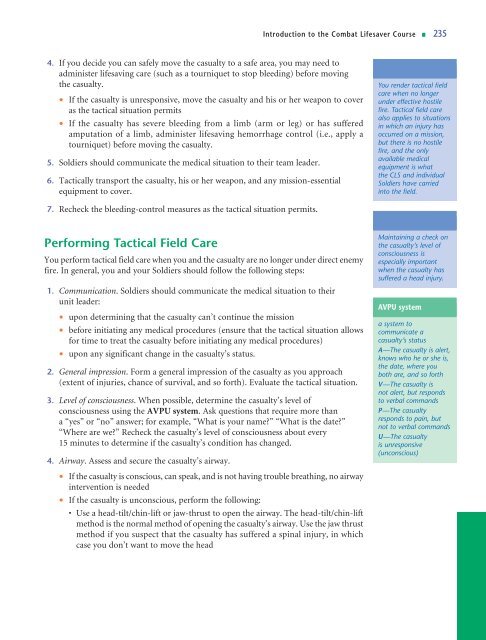introduction to the combat lifesaver course - UNC Charlotte Army ...
introduction to the combat lifesaver course - UNC Charlotte Army ...
introduction to the combat lifesaver course - UNC Charlotte Army ...
- No tags were found...
Create successful ePaper yourself
Turn your PDF publications into a flip-book with our unique Google optimized e-Paper software.
Introduction <strong>to</strong> <strong>the</strong> Combat Lifesaver Course n 2354. If you decide you can safely move <strong>the</strong> casualty <strong>to</strong> a safe area, you may need <strong>to</strong>administer lifesaving care (such as a <strong>to</strong>urniquet <strong>to</strong> s<strong>to</strong>p bleeding) before moving<strong>the</strong> casualty.• If <strong>the</strong> casualty is unresponsive, move <strong>the</strong> casualty and his or her weapon <strong>to</strong> coveras <strong>the</strong> tactical situation permits• If <strong>the</strong> casualty has severe bleeding from a limb (arm or leg) or has sufferedamputation of a limb, administer lifesaving hemorrhage control (i.e., apply a<strong>to</strong>urniquet) before moving <strong>the</strong> casualty.5. Soldiers should communicate <strong>the</strong> medical situation <strong>to</strong> <strong>the</strong>ir team leader.6. Tactically transport <strong>the</strong> casualty, his or her weapon, and any mission-essentialequipment <strong>to</strong> cover.You render tactical fieldcare when no longerunder effective hostilefire. Tactical field carealso applies <strong>to</strong> situationsin which an injury hasoccurred on a mission,but <strong>the</strong>re is no hostilefire, and <strong>the</strong> onlyavailable medicalequipment is what<strong>the</strong> CLS and individualSoldiers have carriedin<strong>to</strong> <strong>the</strong> field.7. Recheck <strong>the</strong> bleeding-control measures as <strong>the</strong> tactical situation permits.Performing Tactical Field CareYou perform tactical field care when you and <strong>the</strong> casualty are no longer under direct enemyfire. In general, you and your Soldiers should follow <strong>the</strong> following steps:1. Communication. Soldiers should communicate <strong>the</strong> medical situation <strong>to</strong> <strong>the</strong>irunit leader:• upon determining that <strong>the</strong> casualty can’t continue <strong>the</strong> mission• before initiating any medical procedures (ensure that <strong>the</strong> tactical situation allowsfor time <strong>to</strong> treat <strong>the</strong> casualty before initiating any medical procedures)• upon any significant change in <strong>the</strong> casualty’s status.2. General impression. Form a general impression of <strong>the</strong> casualty as you approach(extent of injuries, chance of survival, and so forth). Evaluate <strong>the</strong> tactical situation.3. Level of consciousness. When possible, determine <strong>the</strong> casualty’s level ofconsciousness using <strong>the</strong> AVPU system. Ask questions that require more thana “yes” or “no” answer; for example, “What is your name?” “What is <strong>the</strong> date?”“Where are we?” Recheck <strong>the</strong> casualty’s level of consciousness about every15 minutes <strong>to</strong> determine if <strong>the</strong> casualty’s condition has changed.4. Airway. Assess and secure <strong>the</strong> casualty’s airway.Maintaining a check on<strong>the</strong> casualty’s level ofconsciousness isespecially importantwhen <strong>the</strong> casualty hassuffered a head injury.AVPU systema system <strong>to</strong>communicate acasualty’s statusA—The casualty is alert,knows who he or she is,<strong>the</strong> date, where youboth are, and so forthV—The casualty isnot alert, but responds<strong>to</strong> verbal commandsP—The casualtyresponds <strong>to</strong> pain, butnot <strong>to</strong> verbal commandsU—The casualtyis unresponsive(unconscious)• If <strong>the</strong> casualty is conscious, can speak, and is not having trouble breathing, no airwayintervention is needed• If <strong>the</strong> casualty is unconscious, perform <strong>the</strong> following:• Use a head-tilt/chin-lift or jaw-thrust <strong>to</strong> open <strong>the</strong> airway. The head-tilt/chin-liftmethod is <strong>the</strong> normal method of opening <strong>the</strong> casualty’s airway. Use <strong>the</strong> jaw thrustmethod if you suspect that <strong>the</strong> casualty has suffered a spinal injury, in whichcase you don’t want <strong>to</strong> move <strong>the</strong> head
















